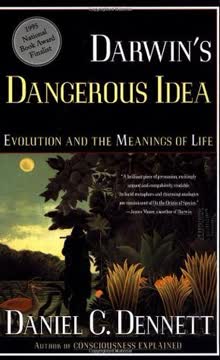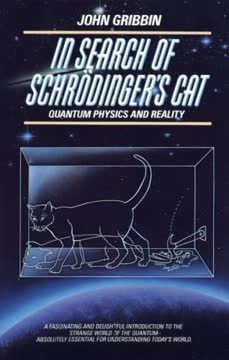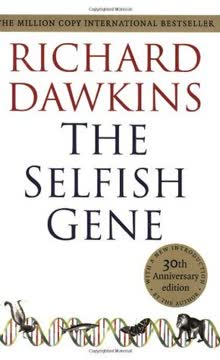Key Takeaways
1. Evolution is a journey through time, with species as fellow pilgrims
We are so used to the idea that mammals stepped into dinosaur shoes, it is surprising to reflect that no dinosaurian 'mole' has so far been found.
A pilgrimage through time. Evolution can be viewed as a grand pilgrimage, with different species joining the journey at various points in Earth's history. This perspective allows us to understand the interconnectedness of all life forms and trace our ancestral lineages back to common ancestors. The concept of "concestors" - the most recent common ancestor shared by two or more species - helps us visualize these evolutionary relationships.
Filling ecological niches. As species evolve and diversify, they often fill ecological roles previously occupied by other groups. For example, mammals evolved to occupy many of the niches left vacant by extinct dinosaurs. However, this process is not always straightforward, as evidenced by the absence of a dinosaurian equivalent to the mole. This highlights the unique evolutionary paths taken by different lineages and the complex interplay between environmental pressures and genetic potential.
2. Genetic evidence reveals unexpected relationships between species
Hippos are closer cousins to whales than hippos are to anything else including other even-toed ungulates such as pigs.
DNA reveals hidden connections. Molecular evidence has revolutionized our understanding of evolutionary relationships, often revealing surprising connections between seemingly disparate species. The close relationship between hippos and whales, for instance, challenges our intuitive classifications based on appearance and habitat.
Rethinking taxonomic categories. These genetic revelations force us to reconsider traditional taxonomic groupings and highlight the limitations of morphology-based classifications. The concept of "grade" versus "clade" becomes crucial in understanding evolutionary relationships:
- Grade: A group of organisms at a similar stage of evolutionary development
- Clade: A group consisting of an ancestor and all its descendants
By focusing on clades, we can better represent the true evolutionary history of species, even when it contradicts our intuitive groupings based on appearance or ecological role.
3. Convergent evolution creates similar traits in unrelated species
Marsupial moles look like true (talpid) moles and golden moles, they feed on worms and insect larvae like true moles and golden moles, and they burrow like true moles and even more like golden moles.
Similar solutions to similar problems. Convergent evolution occurs when unrelated species develop similar traits in response to similar environmental pressures. This phenomenon demonstrates the power of natural selection in shaping organisms to fit their ecological niches, regardless of their evolutionary history.
Examples across diverse lineages:
- Moles: Marsupial moles, true moles, and golden moles
- Flying animals: Bats, birds, and extinct pterosaurs
- Aquatic mammals: Whales, seals, and extinct marine reptiles
These examples highlight how different genetic starting points can lead to remarkably similar adaptations when faced with comparable environmental challenges. Understanding convergent evolution helps us appreciate the versatility of evolutionary processes and the complex interplay between genes and environment in shaping life forms.
4. Mass extinctions reshape the evolutionary landscape
At the Permo-Triassic boundary, a staggering 90 per cent of all species perished without descendants, including all the trilobites and several other major groups of animals.
Catastrophic events drive evolution. Mass extinctions have played a crucial role in shaping the history of life on Earth. These events, often triggered by global catastrophes such as asteroid impacts or massive volcanic eruptions, create opportunities for surviving lineages to diversify and occupy newly vacant ecological niches.
Major extinction events:
- End-Permian (252 million years ago): The most severe, wiping out 90% of marine species and 70% of terrestrial vertebrates
- End-Cretaceous (66 million years ago): Famous for the extinction of non-avian dinosaurs, paving the way for mammalian diversification
- End-Ordovician (445 million years ago): Severely impacted marine life
- Late Devonian (375-360 million years ago): Affected both marine and terrestrial ecosystems
- End-Triassic (201 million years ago): Led to the dominance of dinosaurs
These events serve as stark reminders of the fragility of life and the unpredictable nature of evolutionary history. They also highlight the resilience of life as a whole, with surviving lineages often experiencing rapid diversification in the aftermath of these catastrophes.
5. Fossil records bridge gaps in our understanding of evolution
Given that evolution has happened, it would be weird if there were not intermediates like the cynodonts.
Transitional forms illuminate evolutionary pathways. Fossils provide tangible evidence of evolutionary transitions, helping us understand how major groups of organisms evolved over time. Transitional fossils, such as the cynodonts (mammal-like reptiles), demonstrate the gradual acquisition of mammalian traits from reptilian ancestors.
Key transitional fossils:
- Archaeopteryx: Bridging dinosaurs and birds
- Tiktaalik: Illustrating the transition from fish to tetrapods
- Ambulocetus: An early whale with legs, showing the evolution of cetaceans from land mammals
- Australopithecus: Demonstrating stages in human evolution
While gaps in the fossil record still exist, the abundance of transitional forms discovered so far provides strong support for the theory of evolution. These fossils help us reconstruct the evolutionary history of various lineages and understand the incremental nature of evolutionary change.
6. Artificial selection demonstrates evolution's potential speed
Darwinian selection, if we impose it artificially as hard as we are able, can drive evolutionary change at a rate far faster than we ever see in nature.
Rapid change under human guidance. Artificial selection, as demonstrated in agriculture and animal breeding, shows the potential for rapid evolutionary change when strong selective pressures are applied. This process has produced dramatic changes in domesticated plants and animals over relatively short time periods.
Examples of artificial selection:
- Dogs: From wolves to diverse breeds in a few thousand years
- Maize: Dramatic increases in size and variety from its wild ancestor, teosinte
- Cabbage, broccoli, cauliflower: All derived from wild mustard through selective breeding
The speed of change achieved through artificial selection highlights the power of cumulative selection in shaping organisms. It also serves as a model for understanding natural selection, albeit on a much faster timescale. However, it's important to note that such rapid changes are often not sustainable in natural environments, where multiple, often conflicting selective pressures are at work.
7. Island ecosystems offer unique insights into evolutionary processes
The Galapagos Archipelago is volcanic, and no more than 5 million years old. During that brief existence, a spectacular quantity of diversity has evolved — most famously among the 14 species of finches widely, though perhaps wrongly, believed to have been Darwin's principal inspiration.
Natural laboratories of evolution. Islands, with their isolated ecosystems and unique environmental pressures, serve as ideal settings for studying evolutionary processes. The Galapagos Islands, in particular, have played a crucial role in the development of evolutionary theory, showcasing rapid adaptive radiation and speciation.
Key evolutionary phenomena observed on islands:
- Adaptive radiation: The diversification of a single ancestral species into multiple species adapted to different niches (e.g., Galapagos finches, Hawaiian honeycreepers)
- Island gigantism and dwarfism: The tendency for some species to evolve unusually large or small sizes on islands (e.g., Komodo dragons, extinct dwarf elephants)
- Rapid speciation: The formation of new species over relatively short time periods due to isolation and unique selective pressures
Studying island ecosystems allows scientists to observe evolution in action and gain insights into the processes that drive biodiversity on a global scale. These natural laboratories continue to provide valuable data for testing and refining evolutionary theories.
8. Sexual selection plays a crucial role in shaping species
Given that large size is such an advantage, why weren't the birds just larger in the first place? Because in other years, non-drought years, natural selection favours smaller individuals with smaller beaks.
Beyond survival of the fittest. Sexual selection, a mechanism proposed by Darwin to explain traits that seem detrimental to survival, plays a significant role in shaping species alongside natural selection. This process can lead to the evolution of exaggerated traits that may seem counterintuitive from a pure survival perspective.
Key aspects of sexual selection:
- Male-male competition: Traits that enhance fighting ability or dominance (e.g., large body size, antlers)
- Female choice: Traits that appeal to females (e.g., colorful plumage, elaborate courtship displays)
- Trade-offs: Balancing sexual selection with other selective pressures (e.g., large beaks in Galapagos finches may be advantageous in drought years but disadvantageous in normal years)
Understanding sexual selection helps explain the evolution of seemingly maladaptive traits and highlights the complex interplay between different evolutionary forces. It also underscores the importance of considering both survival and reproductive success when studying evolutionary processes.
9. Molecular clocks help date evolutionary events
Molecular evidence puts the split between camels (plus llamas) and the rest of the artiodactyls at 65 million years, more or less exactly when the last dinosaurs died.
Timing evolution with DNA. Molecular clocks use the accumulation of genetic changes over time to estimate when different species diverged from their common ancestors. This technique complements fossil evidence and allows us to date evolutionary events even when the fossil record is incomplete.
How molecular clocks work:
- Assume a relatively constant rate of genetic mutation over time
- Compare genetic differences between species
- Calibrate the clock using fossil evidence or other geological data
- Estimate the time since divergence based on genetic differences
Molecular clocks have provided insights into many aspects of evolutionary history, including:
- The timing of major evolutionary transitions (e.g., the origin of eukaryotes)
- The divergence of major animal and plant groups
- Human evolution and migration patterns
While molecular clock estimates can be controversial and require careful calibration, they provide a valuable tool for understanding the timing of evolutionary events, especially when combined with fossil evidence.
10. The power of natural selection in shaping adaptations
We can't just compare our brains with those of Homo habilis, Australopithecus or any other species without making allowance for body size.
Adaptive traits in context. Natural selection acts on variations within populations, favoring traits that enhance survival and reproduction in specific environments. However, it's crucial to understand these adaptations in the context of an organism's overall biology and evolutionary history.
Key principles of adaptation through natural selection:
- Variation: Differences among individuals in a population
- Heritability: The ability of traits to be passed on to offspring
- Differential survival and reproduction: Some variants are more successful than others
- Cumulative change: Small advantages accumulate over generations
Examples of complex adaptations:
- Brain size: Must be considered relative to body size (encephalization quotient)
- Sensory organs: The star-nosed mole's unique touch-sensitive appendages
- Physiological systems: The convergent evolution of electric sensing in unrelated fish species
Understanding adaptations requires considering the whole organism, its evolutionary history, and the specific environmental challenges it faces. This holistic approach helps us appreciate the intricate interplay between genes, development, and environment in shaping the diversity of life on Earth.
</instructions>
Last updated:
FAQ
What's The Ancestor's Tale about?
- Exploration of Evolutionary History: The Ancestor's Tale by Richard Dawkins is a narrative journey through the history of life on Earth, tracing the evolutionary paths of various species back to their common ancestors.
- Backward Chronology: The book uses a backward chronology, starting from modern humans and moving back through time to the origin of life, emphasizing the unity of life and shared ancestry.
- Rendezvous Concept: Dawkins introduces "rendezvous points," significant moments in evolutionary history where different lineages diverged, illustrating the interconnectedness of all living beings.
Why should I read The Ancestor's Tale?
- Engaging Narrative Style: Dawkins employs a unique storytelling approach, likening the exploration of evolutionary history to a pilgrimage, making complex scientific concepts accessible and engaging.
- Deepens Understanding of Evolution: The book provides a comprehensive overview of evolutionary biology, making it an excellent resource for understanding how life has evolved over millions of years.
- Challenges Misconceptions: Dawkins addresses common misconceptions about evolution, such as the idea of a linear progression towards humans, emphasizing that evolution is a branching process.
What are the key takeaways of The Ancestor's Tale?
- Unity of Life: All living organisms share a common ancestor, highlighting the interconnectedness of life and the shared lineage of all organisms.
- Evolutionary Patterns: Evolution is not a straightforward path but a complex web of branching lineages, with recurring patterns that provide insights into evolutionary processes.
- Conceit of Hindsight: Dawkins warns against viewing evolution as a linear progression towards humans, arguing that evolution has no privileged line of descent.
What are the best quotes from The Ancestor's Tale and what do they mean?
- "History doesn't repeat itself, but it rhymes.": This quote underscores the idea that while historical events may not occur in the same way, they often share underlying patterns, reflecting Dawkins' view of evolution.
- "Evolution has reached many millions of interim ends.": This highlights that evolution is not a linear process leading to humans but a branching tree with many successful species, emphasizing life's diversity.
- "The conceit of hindsight tempts us at other stages in our history.": Dawkins cautions against viewing past evolutionary events as leading directly to humans, reminding us to avoid anthropocentric interpretations.
How does Richard Dawkins explain the concept of common ancestry in The Ancestor's Tale?
- Shared Genetic Code: Dawkins points out that all living organisms share the same genetic code, serving as evidence of common ancestry.
- Backward Chronology: The book's backward chronology emphasizes that no matter where you start, you will eventually converge on a common ancestor.
- Unity of Life: The concept of common ancestry reinforces the idea that all life is interconnected, highlighting the shared lineage of all organisms.
What role does DNA play in understanding evolution in The Ancestor's Tale?
- Genetic Evidence: DNA is crucial for tracing evolutionary relationships and understanding common ancestry, as all examined organisms share the same genetic code.
- Triangulation of Ancestry: DNA can be used to triangulate ancestry by comparing genetic sequences across species, allowing for plausible reconstructions of ancestors.
- Molecular Clock: Dawkins introduces the molecular clock concept, estimating the timing of evolutionary events based on genetic differences.
How does The Ancestor's Tale address the topic of extinction?
- Natural Part of Evolution: Extinction is a natural part of the evolutionary process, with many species going extinct over time, yet the evidence for evolution remains strong.
- Impact of Human Activity: Dawkins highlights the responsibility humans have for recent extinctions, emphasizing the impact of human activity on extinction rates.
- Lessons from Extinction: Studying extinct species provides valuable insights into the evolutionary process, exploring themes like adaptation and survival.
How does Richard Dawkins explain the concept of speciation in The Ancestor's Tale?
- Geographical Isolation: Geographical barriers can lead to speciation by preventing gene flow between populations, allowing them to evolve independently.
- Sympatric Speciation: Dawkins discusses sympatric speciation, where species diverge in the same area due to behavioral differences or resource specialization.
- Role of Natural Selection: Natural selection favors traits that enhance survival and reproduction, leading to the formation of new species through adaptations.
What is the significance of Madagascar in The Ancestor's Tale?
- Unique Biodiversity: Madagascar exemplifies how isolation can lead to the evolution of unique species, serving as a critical location for understanding evolutionary processes.
- Natural Experiments: The island is described as a "textbook showcase of biogeographical natural experiments," where evolutionary history can be studied in isolation.
- Convergent Evolution: Dawkins discusses how similar traits can evolve independently in different species, illustrated by Madagascar's diverse adaptations.
How does The Ancestor's Tale illustrate the concept of "adaptive radiation"?
- Rapid Speciation: Dawkins uses examples like cichlid fish to illustrate adaptive radiation, where a single ancestral species diversifies into many new species.
- Environmental Pressures: Different environmental pressures lead to the evolution of specialized traits, allowing species to exploit various ecological niches.
- Convergent Evolution: Unrelated species develop similar traits in response to similar challenges, highlighting the dynamic nature of evolution.
How does Dawkins explain the RNA World hypothesis in The Ancestor's Tale?
- RNA as a Precursor to DNA: The RNA World hypothesis posits that RNA molecules were the first self-replicating entities before DNA evolved.
- Autocatalytic Processes: RNA could catalyze its own replication, leading to the emergence of complex life forms over time.
- Experimental Evidence: Dawkins references experiments supporting the hypothesis, demonstrating RNA's ability to replicate and evolve.
What is the Great Historic Rendezvous mentioned in The Ancestor's Tale?
- Origin of Eukaryotic Cells: The Great Historic Rendezvous marks the emergence of eukaryotic cells, a significant transition in life's history.
- Merging of Prokaryotic Cells: This event involved the merging of different prokaryotic cells, leading to the development of eukaryotic cell structures.
- Implications for Evolution: The rendezvous enabled the rise of diverse and complex organisms, highlighting cooperation and symbiosis in evolutionary history.
Review Summary
The Ancestor's Tale is a fascinating journey through evolutionary history, tracing life back to its origins. Readers praise Dawkins' clear explanations, engaging writing style, and the book's comprehensive scope. Many find it awe-inspiring and mind-expanding, appreciating how it connects all life forms. While some note its length and complexity, most consider it worthwhile. Critics highlight occasional digressions and outdated information. Overall, reviewers recommend it as an excellent exploration of evolution, accessible to both science enthusiasts and general readers.
Similar Books










Download PDF
Download EPUB
.epub digital book format is ideal for reading ebooks on phones, tablets, and e-readers.













